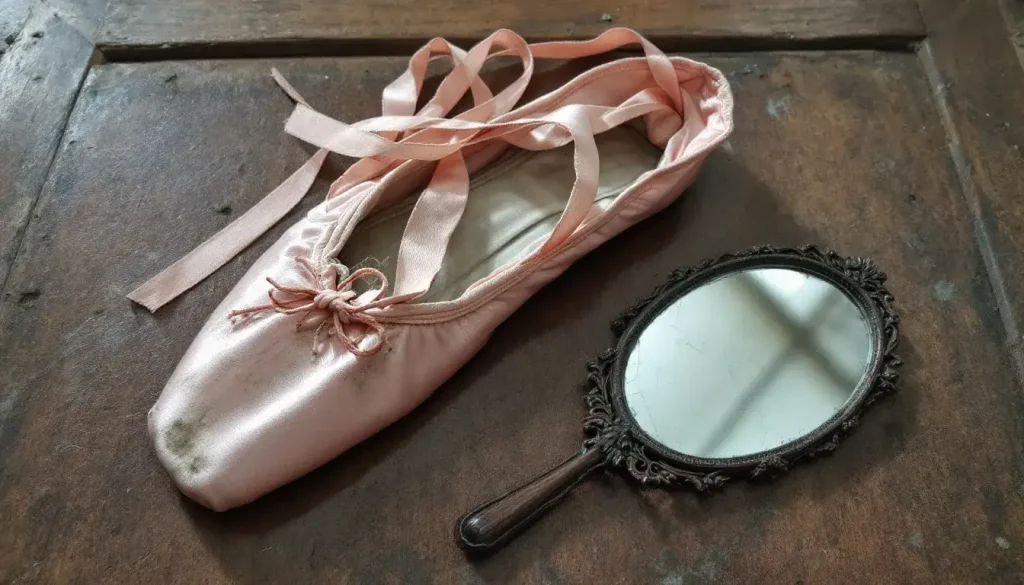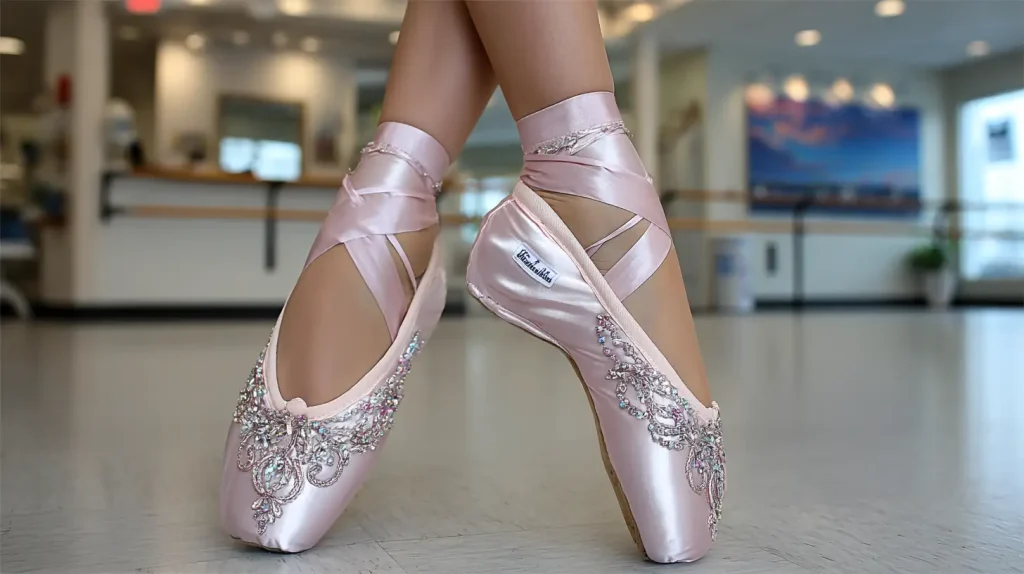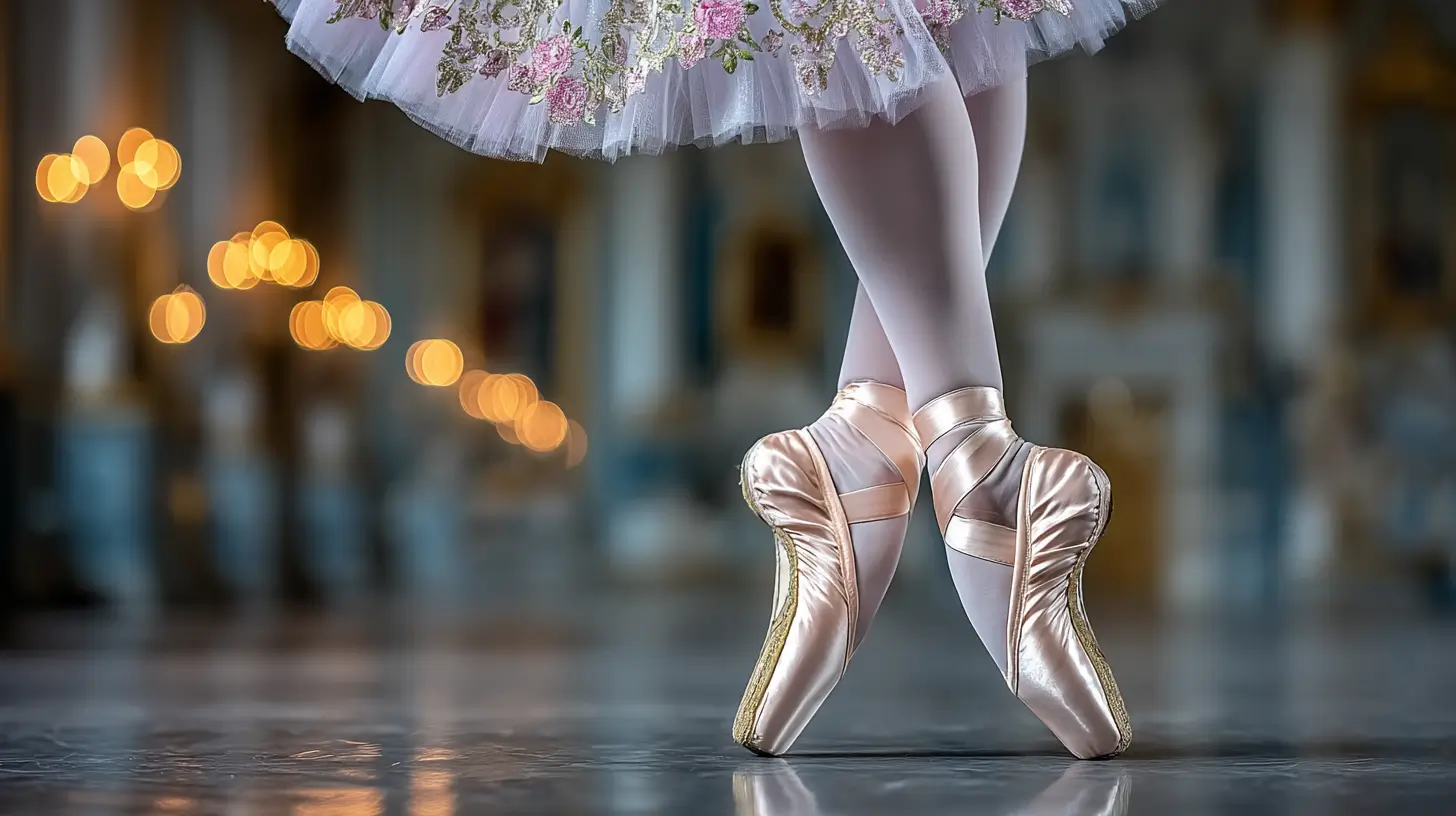How long do pointe shoes last? They last between one pair a week and 4 to 20 hours of dancing. This article explores the factors affecting their lifespan and offers tips on making them last longer.
Graceful Insights
- Pointe shoes typically last 10-20 hours of dance time, with professional dancers needing replacements even sooner.
- Factors like dance frequency, technique, and environmental conditions greatly affect how quickly pointe shoes wear out.
- Proper fit, regular maintenance, and rotating between pairs can significantly extend the lifespan of pointe shoes.
Art de Podcast
| Category | Lifespan | Factors Influencing Lifespan | Tips to Extend Lifespan |
|---|---|---|---|
| Beginner Dancers | 3–6 months (with occasional use) | – Lighter usage due to fewer rehearsals and performances – Developing a technique causing less wear | – Air-dry shoes after practice – Alternate between two pairs to prevent overuse |
| Intermediate Dancers | 1–3 months | – Increased practice hours – Improved strength and technique, leading to more wear – Frequent en pointe exercises | – Store in breathable bags – Use toe pads or tape to reduce friction |
| Professional Dancers | 1–3 weeks | – Rigorous daily training and performances – High impact on the shoe box and shank – Customizations for advanced movements | – Invest in higher-quality, durable pointe shoes – Regularly assess wear to avoid injury |
| Recreational Use | 6–12 months (casual practice) | – Infrequent use keeps shoes intact longer | – Limit practice on hard surfaces – Avoid leaving shoes in damp or closed environments |
| Brand & Material Quality | Varies widely based on design | – Handmade pointe shoes may last longer – Materials like leather and harder shanks offer more durability compared to softer options | – Choose a reputable brand with proven longevity (e.g., Freed, Bloch, or Capezio) – Test fit and break-in before intense usage |
| Specialized Styles | Depends on the purpose (e.g., performances) | – Shoes designed for short-term usage in performances may wear out faster | – Reserve performance shoes exclusively for shows and use separate pairs for practice |
This table shows pointe shoe longevity by experience level, usage type, and influencing factors.
Understanding Pointe Shoe Lifespan

Pointe shoes are crucial for ballet, but their lifespan is surprisingly brief for students. They usually last between 10 and 20 hours of dance time. For seasoned ballet dancers, this age range narrows to about 4 to 12 hours, making the limited lifespan even more striking given the significant investment in time and money.
Pointe shoe longevity varies and is influenced by factors like frequency and intensity of use, individual dance techniques, and environmental conditions. Recognizing these aspects helps dancers manage shoe usage and plan for timely replacements. Dancers with strong, flexible feet and high arches might benefit from a harder shoe, which can provide better support and potentially extend the shoe’s lifespan.
What are Pointe Shoes?
Pointe shoes are specialized ballet shoes designed for dancing en pointe, which means performing on the tips of the toes. They are a fundamental part of a ballet dancer’s attire and provide necessary support and protection for the feet during demanding routines. The key components of pointe shoes include the toe box and the shank.
The toe box is a stiffened area at the front of the shoe, typically made from materials like leather or synthetic composites. This part of the shoe is crucial as it supports the toes and prevents them from breaking, bending, or flexing excessively, which could lead to injuries.
The shank, a reinforced section running along the foot’s arch, adds additional arch support and stability, helping to distribute the balance of the dancer’s weight. Even dancers’ shoes are usually crafted from leather or synthetic materials and feature a soft, padded interior to enhance comfort.
Dancers often use accessories like pads or gel toe spacers inside their shoes to protect their toes further. These additions provide extra cushioning, making the rigorous demands of pointe work more manageable. Whether for professional dancers or students, pointe shoes are indispensable in ballet training, ensuring performance and safety.
Pointe Shoe Fitting Process
The pointe shoe fitting process is critical in a ballet dancer’s journey. A dancer’s proper fit is essential for comfort, support, and injury prevention. Typically, this process involves the expertise of a professional fitter who understands the intricacies of pointe shoe fitting and can guide dancers in selecting the right shoe.
During a fitting session, the fitter assesses various aspects of the dancer’s feet, including size and arch type. They also consider the dancer’s experience, technique, and personal preferences. This comprehensive evaluation helps determine the most suitable shoe.
The dancer will try on several pairs of pointe shoes to find the best fit and support for the first pair. A shoe that is too tight can cause pressure and pain, while one that is too loose can lead to instability and potential injuries. The goal is to find a shoe that fits snugly without causing discomfort, ensuring that the dancer can perform safely and effectively.
A proper fit is not just about comfort; it prevents injuries and enhances performance. A professional fitter can provide valuable advice on caring for and maintaining pointe shoes, ensuring they last longer and perform better.
Factors Influencing Pointe Shoe Durability
Dance frequency, technique variations, and environmental conditions are primary factors in determining the longevity of pointe shoes. Each element uniquely contributes to wear and tear, enabling informed decisions about footwear.
Understanding these factors helps dancers manage the lifespan of their pointe shoes more effectively. Examining each aspect reveals its impact on shoe durability.
Dance Frequency
How often you dance significantly influences how quickly your pointe shoes wear out. Frequent practice and stage performances cause faster deterioration, with professional dancers needing new dance shoes more often due to their daily routines.
Rotating between a few pairs of pointe shoes allows them to dry out completely between pairs of shoes, which can help extend their lifespan.
Intense and regular training can reduce the durability of pointe shoes. Awareness of this helps dancers plan their shoe usage, ensuring a reliable pair is always available for performances.
Dance Technique
Different dance techniques put varying pressures on pointe shoes. Styles with repetitive jumps or turns, for example, cause faster wear. Thus, your dance style and technique significantly influence how quickly you need replacements.
Dancers using strenuous techniques, such as intense jumps or quick turns, will see their pointe shoes wear out faster than those using less demanding styles. Awareness of this can lead to technique adjustments or preparation for frequent replacements.
Environmental Conditions
Humidity and sweat can affect the durability of pointe shoes. High humidity accelerates material breakdown, and sweat can also degrade the boots.
Managing environmental factors like ensuring shoes dry completely between uses can extend their life by mitigating moisture damage.
Signs That Your Pointe Shoes Are “Dead”

Identifying wh “n po “nte shoes are “dead shoes” is crucial “l for performance and safety. A broken shank or a softening box indicates a loss of balance and necessary support for pointe work.
Visible damage, such as frayed satin or detached ribbons, also signals the need for replacement. Identifying these signs ensures timely replacement, performance quality, and safety.
Choosing the Right Pointe Shoes for Longevity

Choosing the right pointe shoes significantly affects their lifespan. Brands with styles for different foot shapes and ensuring proper fit can extend shoe life. Hardening agents like jet glue or wood hardener can also enhance durability.
Customizations like trimming the satin from the toe or reinforcing the toe box can provide comfort and prolong usability. Adjusting elastics and using elasticized ribbons offer better support and preserve shoe longevity.
Importance of Proper Fit
Proper fit is vital for extending the life of pointe shoes. It is essential to try on various shoes to find the right fit, and fitting appointments should consider different foot characteristics.
Accessories like toe pads can ease pain and improve comfort in pointe shoes. However, shoes should not be fitted with a growing room, which could be dangerous.
Recommended Brands
Selecting the right brand ensures longevity and comfort. Brands like Bloch and Capezio are known for their durable pointe shoes, which withstand rigorous use. They are preferred for their quality, craftsmanship, and positive community feedback.
These brands provide styles for various foot types, ensuring a better fit and longer-lasting shoes.
Tips for Extending Pointe Shoe Life

Several strategies can extend the pointe shoe’s life. Regular maintenance, like darning and proper footwear care during training, can prevent injuries and prolong usability.
Rotating between multiple pairs of pointe shoes is another key strategy we’ll explore in the following subsections, especially when choosing your first pair.
Proper Maintenance
Proper maintenance extends the life of pointe shoes. Rotating pairs manage moisture and reduce wear. Shoes should be stored to allow complete air drying, preventing moisture-related deterioration.
Storing pointe shoes in a breathable bag, like a mesh bag or wine tote, ensures proper air circulation. Regular cleaning prevents dirt and wear.
Using Accessories
Accessories like toe pads can significantly increase the longevity of pointe shoes. They provide cushioning and protect the toes and shoes from excessive wear.
Foot care practices, including using toe pads and maintaining proper hygiene, include minimizing the wear of pointe shoes.
Rotation Strategy
Rotating between a few pairs of pointe shoes extends their lifespan. Alternating between a few pairs allows each new pair to rest and recover, reducing cumulative stress and mitigating rapid degradation.
Dancers should aim for at least one pair of pointe shoes to alternate during each week of training. Regular rotation enhances shoe performance and promotes foot health.
Foot Care for Dancers
Foot care is essential to a ballet dancer’s routine, especially when dancing en pointe. The demands placed on the feet can lead to discomfort and injuries if not properly managed. Here are some practical tips for maintaining healthy feet:
- Keep the Feet Clean and Dry: To prevent fungal infections, wash your feet daily and thoroughly dry them, particularly between the toes.
- Use Toe Pads or Gel Toe Spacers: These accessories provide additional cushioning and support, helping to alleviate pressure and discomfort on the toes.
- Trim Toenails Carefully: Keep your toenails trimmed and filed to avoid pressure on the toes and prevent ingrown toenails, which can be painful and lead to infections.
- Use a Pumice Stone: Regularly, gently remove dead skin cells and smooth out rough patches on your feet to keep them soft and healthy.
- Moisturize the Feet: Apply a good moisturizer to keep your feet supple and prevent dryness, especially after dancing.
- Take Regular Breaks: Take regular breaks during practice sessions to give your feet time to rest and recover. This will help prevent fatigue and discomfort.
By following these foot care tips, dancers can maintain healthy feet, reducing the risk of injuries and ensuring they can perform at their best. Listening to your body and caring for your feet is crucial for a long and successful dancing career.
How Professional Dancers Manage Pointe Shoes

Due to intense usage, professional dancers must often break into a new pair of pointe shoes daily. Advanced dancers might break through multiple pairs of pointe work within a term, reflecting increased wear from intensive techniques.
Many professional dancers follow a maintenance routine, regularly checking for wear and ensuring proper fit. They store pointe shoes in breathable containers to prevent moisture buildup and rotate between multiple pairs during training to prolong shoe life.
Common Pointe Shoe Customizations
Customizations enhance comfort and durability in pointe shoes. Common modifications include sewing elastics and darning the platform. Additional adjustments may involve padding, texturizing the outsole, and using non-slip moleskine.
These customizations can significantly improve the lifespan and performance of the first pair of pointe shoes, though they might incur additional costs.
Resume
Summarizing the key points, the lifespan of pointe shoes is influenced by factors like dance frequency, technique, and environmental conditions. Recognizing when your shoes feel “dead” and choosing t “e ri” ht shoes for longevity can make a significant difference. Proper maintenance, using accessories, and adopting a rotation strategy are effective ways to extend the life of your pointe shoes.
By following these insights and tips, you can eventually keep your pointe shoes in optimal condition forever, ensuring that they support your performance and safety for as long as possible. Dance on!
FAQ
What construction materials make some long-lasting pointe shoes more durable than traditional paste shoes?
Modern models that layer thermo-moldable polymers, carbon-fiber shanks, or elastomeric box inserts resist moisture and flex fatigue far better than classic paste-and-paper builds, so they often keep their shape for 20-30 class hours before going “dead.”
How does the studio climate influence how long pointe shoes last?
Heat softens glue and satin; humidity keeps the box from drying fully. A warm, damp studio can cut a shoe’s life in half, whereas airing them near a fan or using desiccant sachets between uses lets them harden again and adds several hours of safe wear.
Can alternating two pairs extend how many hours pointe shoes last?
Yes—rotating pairs allows each shoe to dry at least 24 hours, slowing shank breakdown. Dancers who alternate often see a combined lifespan of 1.5–2 times the hours they’d get by wearing one pair continuously.
Does darning still matter with the latest pointe shoes ballet technology?
Darning the platform with embroidery floss or elastic thread improves grip and spreads impact, even on high-tech shoes. It also protects the satin, adding two to four extra rehearsal hours before visible wear appears.
Why do pointe shoes not last long, even when they fit correctly?
Because the shank and box are engineered to flex with the foot, the forces that create beautiful lines also break down the materials. Proper fit prevents premature collapse, but each relevé still compresses glue layers that can never re-harden fully.
How long do ballet slippers last compared with a pair of pointe shoes?
Canvas or leather ballet flats generally survive several months of daily class—about 100-150 hours—because they lack a rigid shank. By contrast, pointe shoes endure only 10-20 hours for students and sometimes a single performance for professionals.
How can beginners ensure their first pair of pointe shoes lasts longer without risking foot health?
Limit pointe time to short barre segments, let shoes dry completely, avoid over-breaking the shank, and add a light coat of jet glue in the box wings—not on the platform—so the shoe supports growth without becoming rock-hard.
Which signs show that pointe shoes are “dead” and unsafe?
A platform that rolls under pressure, a shank that bends easily past the arch, audible creaking, or a box that feels mushy at the metatarsals all signal the shoe can no longer hold alignment and should be replaced.
For professional dancers, how often do pointe shoes need to be replaced during a busy performance week?
In repertory weeks with eight shows, a principal may burn through two to three pairs per day—roughly 15 pairs—because adrenaline-charged solos and repeated quick changes force shoes past their design limits in minutes.
What foot-strengthening work can extend how long a pair of pointe shoes usually lasts?
Theraband works for the intrinsic toe flexors, controlled rises in parallel, and doming exercises reduce the amount of arch collapse into the shank, spreading the load more evenly and delaying soft spots in the mid-sole.
How do different floor surfaces affect how long ballerina shoes last?
Marley floors are kinder; they create mild friction and wick sweat, so glue dries faster. Unsprung wood stages or concrete overlays trap moisture and grind satin, dramatically shortening pointe and ballet flat lifespans.
Is jet glue or shellac effective, and where should it be applied?
A thin layer inside the box and along the mid-shank, applied while the shoes are still new, can add 30–50 percent more working hours. Avoid the platform, which needs some give for balance.
Are there pointe shoes designed specifically to be long-lasting for touring companies?
Several brands market “tour” or “duration” models with heat-activated plastics and interchangeable shanks; they’re stiffer out of the box but can survive a multi-city run where replacing shoes daily is impractical.
How should pointe shoes be stored between rehearsals to prevent an early “dead” shoe?
Remove toe pads, open the drawstring, and stand them on the platform in a mesh bag with charcoal inserts. Never leave them sealed in plastic or a car trunk, where trapped moisture accelerates breakdown.
Can I recycle or repurpose pointe shoes once they have reached the end of their lifespan?
Yes—dance companies donate dead shoes for costume displays, craft projects, or to schools for demi-pointe training. The satin and ribbons are also popular for up-cycled accessories.
How many hours do point shoes last for male dancers who occasionally perform en pointe?
Because weight distribution differs and usage is sporadic, a pair may last 5–10 stage hours—often spanning an entire production run—before softening enough to require replacement.
Why does a poor pointe shoe fitting shorten shoe life and jeopardize foot health?
If the box is too wide, the metatarsals sink, crushing paste; if it’s too narrow, the quarter fabric splits. Incorrect length forces the dancer to grip with toes, quickly bending the shank at the wrong spot and killing support.
How long do ballet flats last if worn daily in class?
Leather models can retain shape for six months of consistent use; canvas versions breathe better but stretch out sooner, so dancers often replace them every 8–12 weeks to maintain a snug fit and articulate footwork.








